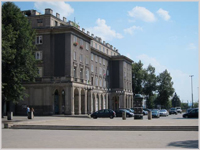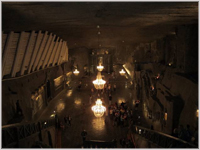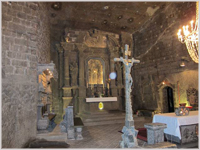 Nowa Huta is a kind of Polish Milton Keynes – but with a somewhat more interesting political history. It was built in Communist times to house people from outlying villages who had been left homeless by the war. But that wasn't the only reason for its birth. The apparatchiks sneered at nearby Krakow as a hotbed of arty intellectuals. At Nowa Huta they built a massive steelworks and commissioned a massive statue of Lenin striding forward in a flapping coat. The idea was to create a Utopia, a model town, to show what the new order could do.
Nowa Huta is a kind of Polish Milton Keynes – but with a somewhat more interesting political history. It was built in Communist times to house people from outlying villages who had been left homeless by the war. But that wasn't the only reason for its birth. The apparatchiks sneered at nearby Krakow as a hotbed of arty intellectuals. At Nowa Huta they built a massive steelworks and commissioned a massive statue of Lenin striding forward in a flapping coat. The idea was to create a Utopia, a model town, to show what the new order could do.
There was a theatre, schools, a hospital.
We venture out on a baking hot afternoon to explore it. The Lenin Steelworks is now called Szensimira. The theatre still functons but the statue has long gone, bought by a Swedish collector and shipped to a museum near Stockholm. Future generations may come to see that as a shame. There's a photo of the statue outside the Stylowa restaurant – where the decor itself is a throwback – and it was clearly a fine piece of work. But for years it had been a focal point for protest against the regime. Locals planted valerian around it, to attract cats, with unpleasant results. One man planted explosives which blew one of its legs off. They couldn't wait to get rid of it.
They were particularly brassed off because they were forbidden to build a church in the town. Even the errection of a wooden cross led to street battles and a military clamp down. But after years of pressure, much of it exerted by Bishop – then Archbishop – Karol Wojtyla before he became Pope John Paul II – the authorities gave in. They wouldn't allow the use of steel from the nearby works, mine, or provide any heavy machinery, so the population hauled up some 2m river stones, from which it is constructed. There is a wedding service about to begin when we get there but we just have time to see the tabernacle, which conceals a chunk of moon rock given by Neil Armstrong to another Pope.
Streets radiate from Nowa Huta's main square like sun rays. The steelworks is now part of Lakshmi Mittal's empire. Apartments in the orginal blocks, built in socialist realism style with heavy renaissance overtones have begun to be sought after. And as this is only one of two such pre-planned towns built, some people believe it could even join the list of UNESCO World Heritage sites.
 The salt mine at Wieliczca is already on that list. Indeed, it was one of the group of first sites, along with others including the Galapagos Islands and Yellowstone National Park, to be so named. If you visit Krakow, on no account miss the opportunity to go there. The mine produced salt from the 13th century until the 1990s. It has been open to tourists for over 200 years. Goethe came to visit, and Chopin, presumably in an attempt to clear up his respiratory problems. The air in its galleries and caverns is reckoned to be good for the health. They incorporate a rehabilitation and treatment centre 135 metres down where people come to exercise and breathe in air full of micro elements.
The salt mine at Wieliczca is already on that list. Indeed, it was one of the group of first sites, along with others including the Galapagos Islands and Yellowstone National Park, to be so named. If you visit Krakow, on no account miss the opportunity to go there. The mine produced salt from the 13th century until the 1990s. It has been open to tourists for over 200 years. Goethe came to visit, and Chopin, presumably in an attempt to clear up his respiratory problems. The air in its galleries and caverns is reckoned to be good for the health. They incorporate a rehabilitation and treatment centre 135 metres down where people come to exercise and breathe in air full of micro elements.
In the Stygian gloom it is easy to imagine workers toiling to hack out the salt and turn it into cylindrical, transportable blocks, collecting water in buckets where it ran off from wooden channels and – before the days of pumps – carrying it to a lift system once powered by plodding horses. But this was no forced labour camp. It was even something of a privilege to work here, and families derived their living from jobs in the mine through successive generations. Most of the present tourist guides are former miners.
There is salt on the damp walls. Salt blooms like cauliflowers on shaft ceilings. There are subterranean lakes where tourists once rode in boats until a terrible accident during the First World War persuaded the operators to introduce vessels which run on rails beneath the water. In one mighty cavern Hitler planned a production unit. Just what was planned my guide doesn't know, but there would have been space for rockets. You can hold business meetings down here – and get married. They joke that couples should be made to walk down hundreds of steps to an underground chapel, so they have plenty of time to think about what they're embarking on.
 One of those chapels, St.Kinga's, is the star attraction. The floors is salt made to look like tiles. The chandelier crystals and alter are of salt. There are fine wall reliefs, depicting scenes from the Bible, all carved from salt blocks. The chapel was created around the end of the 19th century by three miners. It is stunning.
One of those chapels, St.Kinga's, is the star attraction. The floors is salt made to look like tiles. The chandelier crystals and alter are of salt. There are fine wall reliefs, depicting scenes from the Bible, all carved from salt blocks. The chapel was created around the end of the 19th century by three miners. It is stunning.
Salt, of course, was once a kind of white gold. The word for salty in Polish also means pricey. It seems apt, given the hordes of tourists who now come. Its legacy is huge earnings from tourism. We have a bite of lunch underground and take a cramped little lift to the surface, emerging from shafts where the temperature is a constant 14-16C into the fearsome heat of early afternoon.











